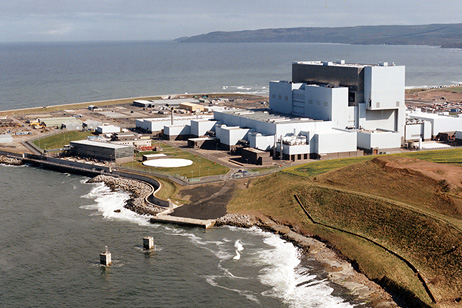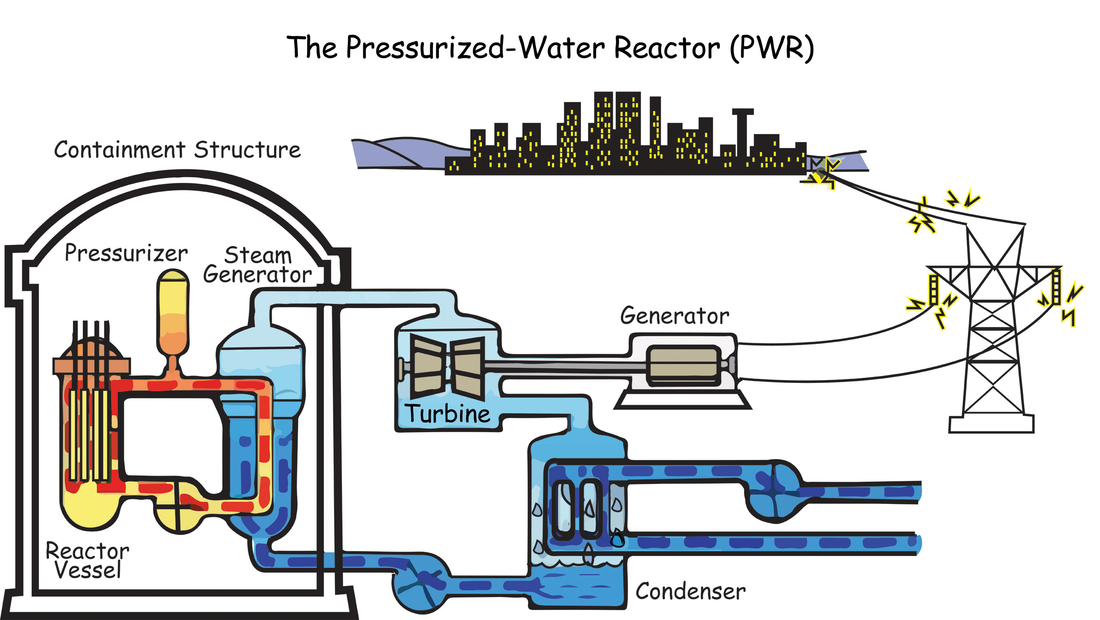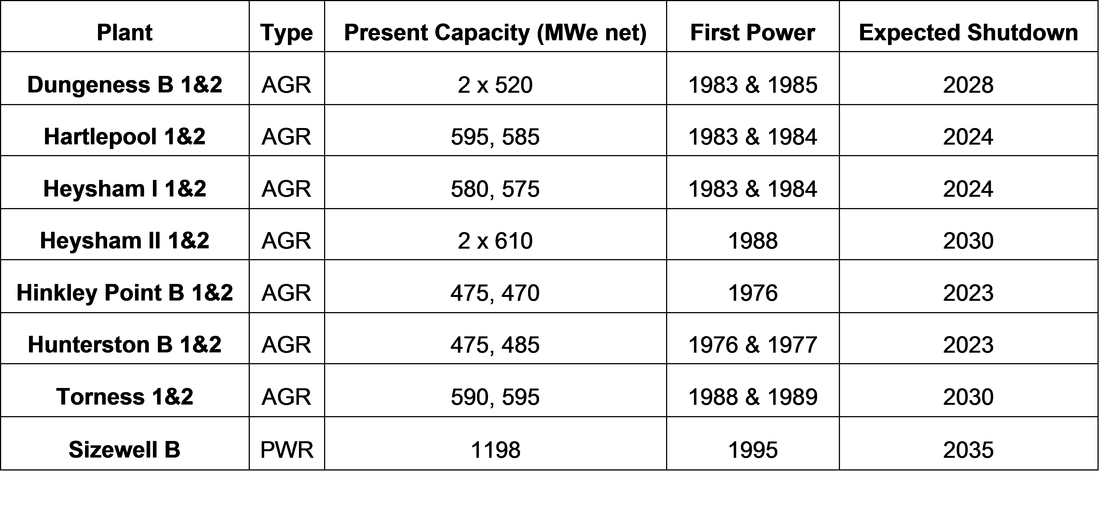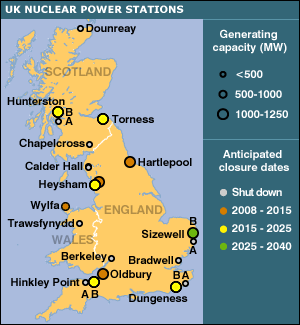Nuclear Power
|
Nuclear power is well established within the UK electricity grid and has been a major supplier of electricity since the 1960’s. Today, approximately 20% of electricity in the UK comes from nuclear power stations (BBC, 2009). It is a very reliable and effective source of electrical power although controversial. This page provides a brief description of Nuclear power, it’s current use in the UK and advantages and disadvantages associated with it.
Nuclear power is considered to be a low carbon method of producing electricity, although there are concerns with other environmental impacts associated with spent fuel disposal, plant decommissioning and release of radioactive material following a severe reactor accident. |
Nuclear Power Station Operation
|
Nuclear power stations use nuclear reactions which release large amounts of heat energy; this heat energy is then transferred by a coolant fluid to a steam generator (see figure 2). Within the steam generator steam is generated and used to power turbines which in turn power generators which then supply electricity to the grid.
The reaction process used is known as nuclear fission whereby the fuel atom is split creating to new atoms and heat. The fusion reaction also releases neutrons which will then go and split other fuel atoms, hence there is a chain reaction occurring. In order to control the number of neutrons flowing and thus the fission process, reactions need to be controlled by the inclusion of neutron absorbing poisons and introducing adjustable control rods into the fuel area within the reactor vessel. |
There are 2 types of nuclear power stations used in the UK today:
PWR reactors use pressurised water in the core to act as the coolant which will transfer the heat from the core to the steam generators. the pressurised water also acts a moderator which acts to effective 'slow down' the neutrons which is done to ensure more neutrons are captured in the fuel for the fission reaction.
AGR reactors are more commonly used in the UK. The main difference to the PWR type of reactor is that the core coolant used is carbon dioxide and graphite is used as the moderator.
There are currently 15 nuclear plants supplying electricity to the UK electricity grid over 7 sites around the country. Table 1 lists the reactor plants and the corresponding capacities including the expected shutdown dates. Figure 3 shows the location of the nuclear power station sites around the UK.
- Pressurised Water Reactor (PWR)
- Advanced Gas Reactor (AGR)
PWR reactors use pressurised water in the core to act as the coolant which will transfer the heat from the core to the steam generators. the pressurised water also acts a moderator which acts to effective 'slow down' the neutrons which is done to ensure more neutrons are captured in the fuel for the fission reaction.
AGR reactors are more commonly used in the UK. The main difference to the PWR type of reactor is that the core coolant used is carbon dioxide and graphite is used as the moderator.
There are currently 15 nuclear plants supplying electricity to the UK electricity grid over 7 sites around the country. Table 1 lists the reactor plants and the corresponding capacities including the expected shutdown dates. Figure 3 shows the location of the nuclear power station sites around the UK.
Advantages and Disadvantages
Advantages
- There are no CO2 emissions or smoke particulates emitted during electricity production, therefore pollution associated with day to day operation of the power station is minimal;
- Increasing energy produced by nuclear power reduces the reliance on fossil fuel power, therefore further reducing CO2 emissions
- Nuclear power stations have a large power density. Nuclear power stations do not require a lot of space like a wind farm does, but will still produce large amounts of energy. They only require to be built near a large body of water for cooling purposes.
- Nuclear power is reliable and is not dependent on the climate;
- Nuclear fuel is a very concentrated source of energy. 1 pellet of low concentrated uranium fuel is equivalent to 8 tonnes of coal. This could also help reduce fuel transportation costs.
- Nuclear power stations can normally run at near to full capacity. A reactor plant typically will operate for 90% of the year.
- Although Uranium is the fuel used in nuclear power plants. It is also possible to fuel nuclear power plants with other fuel types such as Thorium. Thorium is considered a 'greener' alternative. Other nuclear nations such as China and Russia have plans to start using thorium to fuel their future reactors (Energy Informative, 2012).
- Nuclear power station produces a small volume of radioactive waste that has very long half-lives. Handling and disposing of this waste is highly controversial;
- Decommissioning nuclear power stations following their operational life is expensive and takes a long time;
- Although very rare, severe nuclear accidents can result in the spread of radioactive particles over a wide area. Any subsequent contamination can exist for a significant amount of time due to the long half-live associated with many of the fission product materials. The consequences of exposure to high levels of radiation are that it can cause damage to human cells which can cause illness or even death. Any symptoms can take years to develop.
- Any nuclear establishment requires significant security measures;
- Nuclear power cannot respond quickly to changes in demand and requires long ‘start-up’ times.
References:
BBC, 2009. Guide to UK Nuclear Power.
Energy Informative, 2012. Nuclear Energy Pros and Cons.
Nuclear Energy, 2014. Nuclear Energy Advantages and Disadvantages.
Sir Robert McAlpine, 2016. Torness Power Station.
United States Nuclear Regulatory Commission, 2016. What is Nuclear Energy.
World Nuclear Association, 2016. Nuclear Power in the United Kingdom.
BBC, 2009. Guide to UK Nuclear Power.
Energy Informative, 2012. Nuclear Energy Pros and Cons.
Nuclear Energy, 2014. Nuclear Energy Advantages and Disadvantages.
Sir Robert McAlpine, 2016. Torness Power Station.
United States Nuclear Regulatory Commission, 2016. What is Nuclear Energy.
World Nuclear Association, 2016. Nuclear Power in the United Kingdom.



